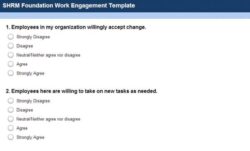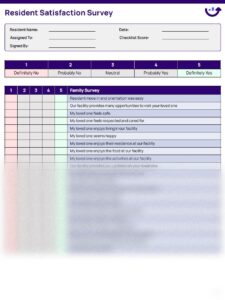Ever wondered how communities truly grow and thrive? It’s not just by chance, but often through a deep understanding of what their residents genuinely need. A community needs assessment is the compass that guides these efforts, helping local organizations, governments, and non-profits pinpoint challenges and opportunities. And at the heart of this crucial process often lies a well-crafted survey, designed to gather direct feedback from the people who live and breathe the community’s realities every day.

Creating an effective survey from scratch can feel like a daunting task, can’t it? That’s where a thoughtfully designed community needs assessment survey template becomes your best friend. It provides a structured framework, ensuring you cover all your bases while saving valuable time and resources. This guide will walk you through what makes an excellent template and how you can use one to unlock meaningful insights for your community’s betterment.
Understanding the Core Components of a Community Needs Assessment Survey Template
When you’re looking to gauge the pulse of a community, a robust survey template isn’t just a collection of questions; it’s a carefully structured tool. It typically starts with clear objectives in mind: what exactly do you want to learn? From there, it branches out into various sections, each designed to capture specific types of information. Think of it as building a house – you need a solid foundation before you add the walls and roof.
A good template will usually begin with some basic demographic questions, not to pry, but to help you understand if certain needs are more prevalent among specific groups within your community. This data is invaluable for targeted interventions. Following this, the template delves into specific areas of community life, exploring satisfaction levels and identifying gaps in services or resources. These questions can range from housing stability to access to education, healthcare, and local amenities.
It’s crucial that the template incorporates a mix of question types. Closed-ended questions, like multiple-choice or rating scales, are excellent for quantitative data and easy analysis. However, open-ended questions are where the real stories often emerge. They allow respondents to express their thoughts, concerns, and suggestions in their own words, providing rich, qualitative insights that you might not have anticipated. A balanced approach ensures you get both the numbers and the narratives.
Furthermore, a well-rounded community needs assessment survey template isn’t static. It’s often the result of lessons learned from previous assessments, continually refined to be more effective and user-friendly. The questions are phrased neutrally to avoid leading respondents, and the language is kept accessible, steering clear of jargon that might confuse or alienate participants. The aim is always to encourage honest and comprehensive feedback from everyone.
Key Areas to Cover in Your Template
- Housing and Shelter: Affordability, availability, quality, homelessness support.
- Health and Wellness: Access to healthcare, mental health services, healthy food options, recreational facilities.
- Education and Workforce Development: School quality, adult education, job training, employment opportunities.
- Safety and Security: Crime rates, community policing, emergency services preparedness.
- Transportation: Public transit availability, road conditions, pedestrian and cycling infrastructure.
- Environment and Public Spaces: Green spaces, air and water quality, waste management, parks.
- Social Cohesion and Engagement: Opportunities for community involvement, support networks, cultural events.
- Economic Opportunity: Local businesses, job growth, income levels, poverty alleviation.
By thoughtfully addressing these diverse categories, your community needs assessment survey template helps paint a comprehensive picture of your community’s strengths and weaknesses. This holistic view is essential for developing programs and policies that truly resonate with the community’s real-world experiences.
Crafting Your Effective Community Needs Assessment Survey Template
Once you understand the fundamental building blocks, the next step is to put them into action and craft a template that truly serves your unique community. This process isn’t just about listing questions; it’s about strategic planning to ensure the data you collect is actionable and impactful. Think about who needs to be involved in the design process – often, including community members themselves can lead to a more relevant and well-received survey.
One of the most critical aspects of developing an effective community needs assessment survey template is to keep the language simple and clear. Avoid jargon, technical terms, or overly complex sentence structures. Your goal is to make it easy for everyone, regardless of their background or education level, to understand and respond accurately. Ambiguous questions lead to ambiguous data, which isn’t helpful for anyone trying to make informed decisions.
Consider the length of your survey. While you want to gather comprehensive data, survey fatigue is a real phenomenon. A lengthy survey can lead to rushed answers or abandonment, skewing your results. A good template balances the need for detail with respect for the respondent’s time. Often, it’s better to have a slightly shorter, highly focused survey that gets completed than a super-detailed one that’s only partially filled out.
When you’re ready to put your community needs assessment survey template into action, think about how you’ll distribute it. Will it be online, paper-based, or a combination? Ensuring accessibility for all community members, including those with limited internet access or disabilities, is vital. This might involve offering multiple formats, providing assistance with completion, or hosting community feedback sessions.
- Define your objectives clearly before writing any questions.
- Keep it concise but comprehensive, respecting respondents’ time.
- Pilot test your survey with a small group to catch any confusing questions.
- Ensure accessibility for all residents, offering various participation methods.
- Phrase questions neutrally to avoid bias and encourage honest responses.
Finally, remember that creating the template is just the beginning. The real power of a well-designed community needs assessment survey template comes when you analyze the collected data and translate those insights into concrete actions. It’s about empowering your community with information, fostering a sense of ownership, and driving positive, sustainable change based on authentic needs.
In essence, a meticulously designed community needs assessment survey template isn’t merely a document; it’s a vital instrument for fostering stronger, more resilient communities. By systematically gathering insights directly from residents, organizations can move beyond assumptions and base their initiatives on tangible needs and aspirations. This approach not only ensures resources are allocated effectively but also builds trust and empowers community members to be active participants in their own development.
Embracing a structured approach to understanding community needs through such a template truly paves the way for informed decision-making and collaborative problem-solving. It allows for the creation of programs and services that genuinely resonate with the population, leading to meaningful and lasting improvements in the quality of life for everyone involved. It’s about listening intently, acting thoughtfully, and growing together.


